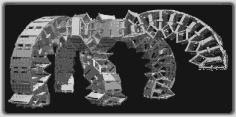MTRAN
modular robots have been intensively investigated mainly by universities and research institutes in Japan and USA since around 1990 as the robots' versatility, flexibility and fault-tolerance has been attracting researchers' interest.
Experiment of self-reconfiguration by 9 module
As MTRAN is rather smaller and lighter than ever, both self-reconfiguration and dynamical motion of a group is made possible

http://staff.aist.go.jp/e.yoshida/test/research-e.htm
PolyBot
PolyBot is made up of many repeated modules. Each module is virtually a robot in and of itself having a computer, a motor, sensors and the ability to chains PolyBotattach to other modules. In some cases, power is supplied off board and passed from module to module. These modules attach together to form , which can be used like an arm or a leg or a finger depending on the task at hand.
http://www2.parc.com/spl/projects/modrobots/chain/polybot/index.html
PolyBot
Polypod is a bi-unit modular robot. This means that the robot is built up of exactly two types of modules that are repeated many times. This repetition makes manufacturing easier and cheaper. Dynamic reconfigurability allows the robot to be highly versatile, reconfiguring itself to whatever shape best suits the current task. To study this versatility, locomotion was chosen as the class of tasks for examination.
http://www2.parc.com/spl/projects/modrobots/chain/polypod/index.html
Digital Clay
At Xerox PARC it is a subset of the modular robotics project. As such it is a stripped down version of a modular robot. That is, there is a) no active coupling and b) no actuation for producing module to module motions. Changes to an assembly of modules is made by a user. But it embodies one very important aspect—that the modules have some capacity to sense or know their own orientation in space with respect to other modules. As such it may be a useful hardware system for testing software, communications, power distribution for physically modular and reconfigurable systems.
http://www2.parc.com/spl/projects/modrobots/lattice/digitalclay/index.html
Modular Snake Robots
Snake robots can use their many internal degrees of freedom to thread through tightly packed volumes accessing locations that people and machinery otherwise cannot use. Moreover, these highly articulated devices can coordinate their internal degrees of freedom to perform a variety of locomotion capabilities that go beyond the capabilities of conventional wheeled and the recently developed legged robots. The true power of these devices is that they are versatile, achieving behaviors not limited to crawling, climbing, and swimming.
http://www.cs.cmu.edu/~biorobotics/projects/modsnake/modsnake.html
MTRAN3 Modular Robot
Modular robot reassembles when kicked apart
A robot developed by roboticists at the University of Pennsylvania is made of modules that can recognise each other.